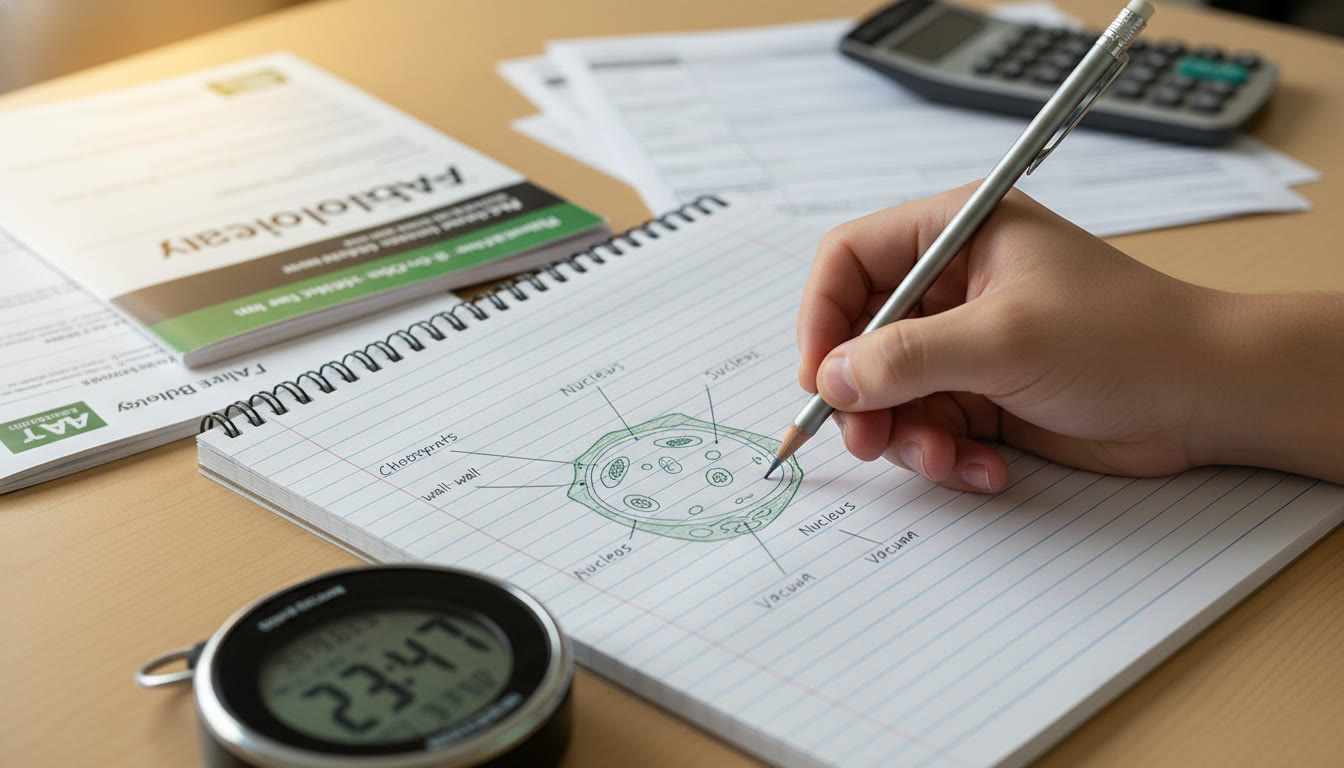Why Diagrams Matter: More Than Pretty Pictures
When you sit down to tackle a Science FRQ on an AP exam, the clock is running and your brain wants to sprint to words. But a well-drawn diagram can be one of the most efficient ways to communicate an idea — often faster and clearer than several sentences. A diagram does more than decorate your answer: it organizes information, shows relationships, and often makes implicit assumptions explicit. In short, a good diagram can carry meaning and earn you points when words fall short.
The exam truth: graders look for clarity and relevance
College Board readers are trained to award points for the accuracy and clarity of scientific reasoning. A diagram that is neat, labeled, and directly tied to the question’s demands helps graders see the candidate’s thinking. Conversely, a vague sketch or an unlabeled scribble can obscure understanding and cost you points—even if your underlying idea was correct.

Start With the Question — What Must the Diagram Show?
Before you put pencil to paper, ask four quick questions:
- What specific relationship or process is the prompt asking me to show?
- Which variables or components must appear (e.g., forces, vectors, species, reagents, organelles)?
- Does the question require quantitative information (values, magnitudes) or qualitative relationships (direction, increase/decrease)?
- Will annotations (labels, arrows, short notes) help justify the answer?
Keep your diagram focused on what the prompt asks. Extra elements can confuse the grader and dilute the point you’re trying to make.
Goal-Oriented Diagramming
If the question asks about energy transfer, draw the flow of energy and label inputs/outputs. If it asks about concentration gradients, show the gradient visually and annotate with relative concentrations. Always prioritize the elements that link directly to how the point is earned on the rubric.
Elements of a Clear Scientific Diagram
Across AP Biology, Chemistry, and Physics, the same fundamentals apply. Consider these essential features:
- Scale and Proportion: Use relative sizes or arrow lengths to imply magnitude when it’s relevant.
- Labels: Every part that matters should be labeled clearly. Abbreviations are fine if they are standard or explained.
- Arrows and Direction: Indicate movement, forces, or reaction direction with arrows. Make arrowheads clear and consistent.
- Units and Values: Where numbers matter, include them with units (e.g., N, mL, M, m/s).
- Legibility: Write big enough for a grader to read; avoid crowded text or overlapping lines.
- Key or Legend: For complex diagrams, a short legend prevents confusion.
Quick Checklist to Use Before Submitting
- Is every critical element labeled?
- Are arrows used to show direction where necessary?
- Do any values or units match what the prompt requested?
- Is the diagram referenced in your written explanation (e.g., “see diagram”)?
Common Diagram Types by Subject
Understanding the typical diagram forms for each AP science course helps you practice intentionally.
AP Biology
- Cell diagrams (organelles labeled, movement across membranes shown)
- Population or community flow charts (energy, nutrient cycles, trophic levels)
- Experimental setups (control vs. experimental group, variables labeled)
AP Chemistry
- Molecular diagrams showing bonding or electron flow
- Reaction coordinate diagrams (activation energy, ΔH labeled)
- Lab apparatus sketches to show setups like titrations or calorimetry
AP Physics
- Free-body diagrams with force vectors and magnitudes
- Motion graphs and system diagrams indicating initial conditions
- Electrical circuit diagrams with components and current directions
Annotated Examples: What Earns the Points
Rather than dwell on theory, let’s look at practical, exam-ready diagram styles and why they work. Below are three concise examples with the features that make them effective.
| Scenario | Diagram Features | Why It Works |
|---|---|---|
| Diffusion across a membrane (AP Bio) | Simple membrane drawn, solute concentration indicated by dot density, arrows showing net movement, labels: high [X], low [X] | Visually shows gradient and net flux; labels connect diagram to text explanation about concentrations. |
| Free-body diagram for block on incline (AP Physics) | Block drawn on slope, gravity vector mg, normal force N perpendicular, friction arrow opposite motion, angle θ, force components labeled | Separates vectors and components; immediately useful for writing equations and solving values. |
| Reaction coordinate (AP Chem) | Energy vs. reaction progress graph, labeled Ea, ΔH, and transition state, reactants and products marked | Highlights activation barrier and enthalpy change concisely; connects to kinetics and thermodynamics discussion. |
How to Pair Diagrams with Short, Powerful Text
After drawing, use a one- or two-sentence annotation explaining the diagram’s significance. For example: “Arrows indicate net diffusion from high to low solute concentration, demonstrating passive transport and no ATP requirement.” This ties the visual back to the rubric and clarifies what you intend the grader to read.
Practice Exercises You Can Do in 15 Minutes
Regular, focused practice is the fastest way to improve diagram skills. Try this simple routine three times a week:
- Pick a past FRQ or create a prompt (5 minutes): scan the prompt and underline the diagram requirements.
- Sketch (5 minutes): draw a focused, labeled diagram using the checklist above.
- Annotate and explain (5 minutes): write 2–3 sentences linking diagram features to the answer.
Repeat the routine and track improvement: compare early sketches with later ones and note clarity, labeling, and how often a diagram helped you find the answer faster.
Specific Tips and Shortcuts for Exam Day
On the day of the test, stressed hands and a ticking clock make simple habits essential. Here are tactical shortcuts that preserve clarity without wasting time.
- Start with a light pencil outline. Use a darker pen only after you’re sure of placement.
- Use standardized symbols: arrowheads for flows, dashed lines for hypothetical boundaries, and a small key if you reuse nonstandard symbols.
- If a precise scale is unnecessary, indicate relative magnitudes with short notes like “2×” or “larger.”
- When forced to choose, prioritize labeling over artistic detail. A labeled stick figure beats a detailed but unlabeled drawing.
- Reference your diagram in text: a brief phrase like “(see diagram)” helps the grader connect the two parts of your answer.
Saving Time Without Sacrificing Points
If the prompt asks for multiple subparts, draw one comprehensive diagram at the top and annotate only the parts relevant to each subpart. This avoids redrawing similar scenes, keeps your notebook tidy, and reinforces a cohesive model for the grader to follow.
Common Pitfalls and How to Avoid Them
Knowing what students frequently do wrong helps you avoid those traps. Here are mistakes to watch for and quick fixes:
- Overcomplicating: Adding unnecessary components can confuse the core idea. Fix: strip the diagram back to the essentials required by the prompt.
- Vague Labels: Labels like “stuff” or “particles” are worthless. Fix: use precise terms (e.g., “Na+ ions,” “ATP,” “normal force N”).
- No Directionality: Forgetting arrowheads or directions leads to ambiguity. Fix: always show the direction for movement, current, or force.
- Clashing Units: Using inconsistent or missing units undermines numerical answers. Fix: write units as you calculate and transfer them to the diagram if required.
- Disconnected Text and Diagram: If the diagram and written answer don’t reference each other, graders may miss your point. Fix: mention the diagram in your text and vice versa.
How Tutors and Targeted Feedback Speed Things Up
Improving diagrams is not just about practice; it’s about practicing the right way. Working with a knowledgeable tutor gives you individualized feedback — pointing out where labels are ambiguous or where a diagram could be simplified for clarity. For example, a tutor can help you standardize symbol use across subjects, rehearse timed diagramming under realistic conditions, and suggest small habits (like always labeling axes first) that save time during the exam.
If you’re exploring personalized help, Sparkl’s personalized tutoring offers 1-on-1 guidance, tailored study plans, expert tutors, and AI-driven insights that can highlight recurring weaknesses in your diagrams and create focused practice to fix them. Such targeted practice is especially valuable when you’re trying to convert a technical skill into an automatic exam-day habit.
Real-World Connections: Why Clear Diagrams Matter Beyond the Exam
Diagrams are the language of science. Engineers, researchers, and clinicians rely on visuals to share complex information quickly. The exam is a practice ground for this real-world skill: clarity, efficient storytelling, and precise labeling are universally valued. Whether you’ll draw reaction mechanisms in a lab notebook, sketch a circuit in an engineering design meeting, or map evolutionary relationships in a field study, the same principles apply.
Example: From Classroom to Lab Notebook
Imagine you’re describing an enzyme assay in a lab: a clear diagram showing substrate concentration, reaction vessel, and sampling points can save hours of confusion. The habit of including units, timepoints, and reagent names in your AP diagrams translates directly to better scientific communication in college and beyond.
Checklist: Diagram Rubric for Self-Assessment
Before you finish an FRQ, run your diagram through this quick rubric. If you answer “no” to any item, spend 30–60 seconds improving it.
- Does the diagram show the relationships or components the question asked for?
- Are all critical parts labeled with precise terms?
- Are directions, flows, or vectors shown clearly?
- Have units or key values been included where necessary?
- Is the diagram readable and referenced in the text?
- Does the diagram avoid unnecessary information that distracts from the main point?
How to Practice with Past FRQs
Free-response questions from past AP exams are one of the best study tools. Pick a question, set a timer, and do the diagraming steps as if it were test day. Afterward, compare your diagram to the scorer’s rubric or model answer: does your visual communicate the exact points the rubric rewards? If not, identify which element was missing (labeling, arrow direction, units) and add that to your practice checklist.
Sample Mini-Drill
Try this 20-minute drill three times week for two weeks:
- Choose three past FRQs from different AP science subjects.
- For each: 7 minutes to draw and annotate, 5 minutes to write the short explanation, 3 minutes to self-assess with the rubric, and 5 minutes to revise the drawing based on assessment feedback.
- Keep a log of recurring issues and focus the next session on fixing one repeated mistake.
Final Thoughts: Communicate Clearly, Earn Confident Points
A strong diagram is a high-yield strategy on AP science FRQs. It condenses complex relationships into a visual conversation with the grader. The best diagrams are purposeful, labeled, readable, and directly tied to the rubric’s demands. With deliberate practice, targeted feedback, and a few exam-day habits, your diagrams will stop being an afterthought and start being an asset.

Remember: clarity beats complexity. Practice drawing with intention, check your work against the rubric, and when helpful, seek tailored feedback — whether from a teacher, a tutor, or a personalized program like Sparkl’s tutoring — to convert diagramming from a skill you struggle with into an exam-day advantage. Good luck — draw clearly, write concisely, and let your diagrams do the talking.




















No Comments
Leave a comment Cancel